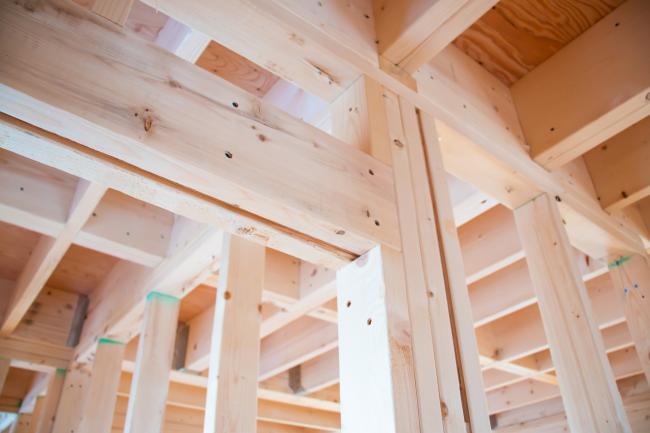
Discussing these benefits with your clients sets you apart in the competitive construction industry. From its unmatched strength and durability to its natural insulation properties and energy efficiency, timber framing offers a host of advantages that can enhance the quality, sustainability, and overall appeal of the homes you build. Engaging with your clients about these benefits not only educates them but also helps you establish trust and demonstrate your commitment to using superior building practices.
1. Strength and Durability
Timber frames are durable and provide exceptional structural integrity. Timber's natural resistance to expansion and contraction from temperature changes prevents cracking and ensures long-lasting stability. Additionally, advancements in engineered wood enhance tensile strength, making timber frames capable of supporting large, open spaces and high ceilings, resulting in homes that endure for generations.
2. Naturally Insulating
Timber framing acts as a natural insulator due to tiny air pockets within the wood that resist heat flow. With thoughtful design, timber-framed buildings can better regulate internal temperatures, reducing the need for heating and cooling and ultimately lowering household energy consumption.
3. Sound & Acoustics
Timber's natural density and insulating properties help reduce noise transmission, creating a quieter indoor environment for occupants. Timber frames can also be designed to enhance acoustic properties, making homes more peaceful and comfortable.
4. Energy Efficiency
Because their naturally insulating properties, timber framed houses can be highly energy efficient and help to regulate indoor temperatures This not only lowers energy bills but also contributes to a more comfortable living environment year-round.
Advancements in timber framing techniques and materials, such as improved insulation and sealing methods, further enhance energy efficiency by minimizing heat loss and ensuring better overall thermal performance. Opting for a timber framed house can lead to significant savings in energy costs while promoting sustainability and comfort for homeowners.
Additionally, timber framing has low embodied energy when compared to many other mainstream building materials. This means that from planting and harvesting to manufacturing, transportation, and installation, timber framing requires the least amount of energy throughout its entire production process. Innovations in technology are also increasing yields from each log, minimizing waste and further reducing overall energy consumption in the process of your build too.
5. Lightweight and Fast Assembly
Timber framing's inherent lightweight properties simplify transportation and installation. This can boost onsite productivity and reduce delays caused by adverse weather conditions.
Builders' extensive experience and expertise in timber framing also ensures an efficient construction process, optimizing project timelines and overall efficiency.
6. Contrary to popular belief, timber framing burns predictably
Timber framing has significant insulating properties causing it to burn in a slow, predictable, and measurable way while maintaining its structural integrity. It can also be protected from fire with cladding. If designed and built according to code, timber performs strongly against fire, giving builders the ability to confidently create strong, durable, fire-resistant buildings.
7. Sustainable and Renewable
When discussing timber framing benefits with clients, it's important to mention that the timber sourced for their home is certified sustainable. Timber sourced from sustainably managed forests is one of the most environmentally friendly building materials available.
Wood sourced from responsibly managed forests and plantations plays a crucial role in reducing atmospheric carbon by storing it. As trees grow, they naturally absorb carbon dioxide from the atmosphere, which remains sequestered within the wood long after harvesting. Approximately half of the dry weight of timber framing is carbon, which remains stored for the duration of its use.
But what about the trees?
Forest management for wood production is a commercial activity. It is in the interests of forest growers and their customers to replant harvested trees to ensure a thriving and renewable business.
In Australia, more than 70 million seedlings are planted each year by Australia’s plantation owners, while native forest managers renew or regrow their forests through natural and artificial reseeding. Each year, more seedlings are planted than have been harvested.
The entire lifecycle of timber, from sapling to installation, results in a net removal of carbon dioxide from the atmosphere. Younger trees are especially efficient at absorbing carbon dioxide too, making the replacement of harvested trees beneficial for carbon sequestration. It only makes sense to maintain forest health and carbon storage capabilities for future generations.
8. Simple Installation of Services
Timber frames are ideal for installing plumbing and electrical cables because they can be easily drilled, unlike some materials that require cushioning grommets to protect cable insulation. This makes the installation process simpler and more efficient. Additionally, timber frames minimize long-term damage to plumbing by reducing the risks associated with expansion, contraction, and corrosion.
9. Easy Renovations and Extensions
When renovations are needed, such as when a family outgrows their home, timber framing is easy to work with. Whether you need to remove existing framing, add new timber framing, or both, the process is straightforward. And your designers, builders, and tradespeople are already experienced with timber framing which ensures a smooth and efficient renovation process for your clients.
10. Low-cost and Flexible
Timber framing elements are often prefabricated or built offsite. This means quick installation and easy last-minute changes or adjustments onsite. This all contributes to reduced delays and boosted on-site productivity for your building team.
11. What about termites?
Choose treated timber. Termite-treated timber framing offers robust protection for homes against termite infestations from the inside out. The active ingredient, commonly found in head lice shampoo and flea collars, effectively prevents borers from damaging the structure. Treated timber has a low initial cost and eliminates the need for annual inspections, providing a reliable and cost-effective solution. Treated timber has a low initial cost and eliminates the need for annual inspections, providing a reliable and cost-effective solution for home builders.
Check out our design and installation guides for more information on working with timber.
